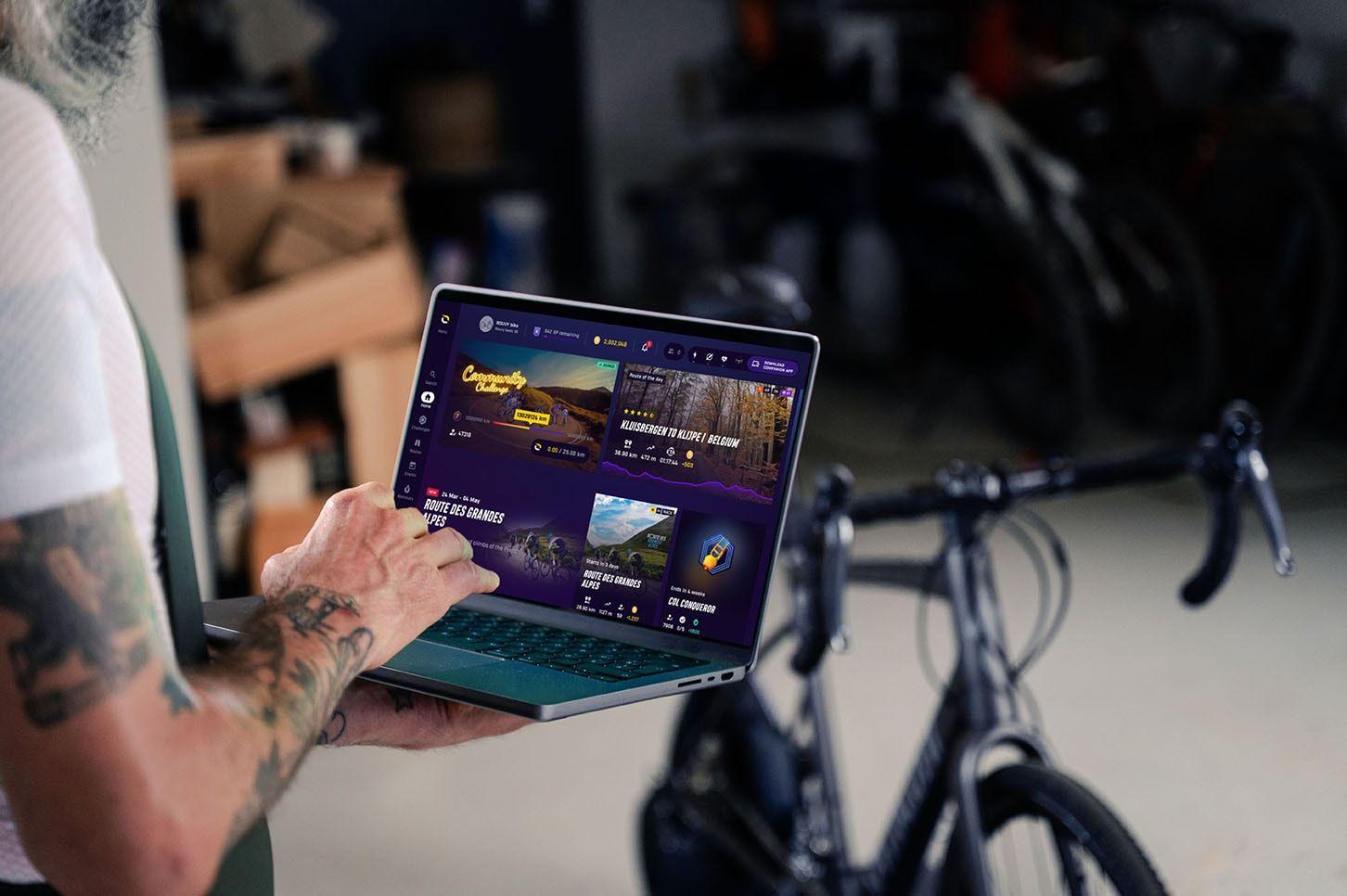There’s no denying that AI is changing the world – and much more than we might think. With platforms such as Chat GPT, and AI integration into everything from phones to sunglasses, we’re in an era where it’s now part of day-to-day life.
But, would you consider using an AI cycling coach to transform your training?
AI has been part of endurance sports for longer than many people realize – just not at the level we see today. Leading fitness-tracking apps such as Strava, TrainingPeaks and Garmin Connect have incorporated AI-powered elements that can analyze performance data and help athletes train more effectively. These systems laid the groundwork for today’s advanced AI cycling training plans.
Key differences between AI coaching and traditional coaching
AI coaching is driven by data and algorithms, whereas traditional coaching is built on human experience and communication. Both have advantages and interpret training variables differently. An AI cycling coach excels at data-driven analysis and adapting quickly to metrics, while a human coach brings empathy, emotional intelligence and motivation to the process.
What is an AI cycling coach?
An AI cycling coach is a computer-generated system that helps you train more effectively, whether you’re preparing for a race or improving fitness. It can plan workouts, help manage recovery and recommend optimal training loads. By analyzing your performance data, it adapts your AI cycling training plan to ensure consistent progress and reduce the risk of overtraining.
Essentially, a smart cycling coach is a digital platform that uses algorithms to analyze data and provide personalized recommendations. It processes your performance metrics to guide your training progression – much like a human coach, but with greater speed and precision.
The technology behind AI training for cyclists combines several key elements. Data analysis provides valuable insights into performance. Machine learning enables the system to recognize patterns and trends. Finally, predictive modelling allows a virtual cycling coach to forecast future performance and adjust training accordingly – mirroring the logic of traditional coaching, but enhanced by vast data-processing power.
How AI coaches work in cycling
An AI cycling coach functions similarly to a traditional coach but can process data much faster. The more data you provide, the more personalized your AI cycling training plan becomes.

What data can we give AI as cyclists? Well, there’s so much we can provide to help make the perfect training program. Firstly, we have personal data such as age, height and weight. You also have medical data and previous experience with cycling. An effective AI coaching platform can then connect to your history; see ride data; monitor heart rate, power, cadence; and much more. The more data you give it, the more personal the program.
One of the biggest advantages of AI training for cyclists is adaptability. As your performance changes, so does your plan. A virtual cycling coach can adjust sessions based on progress, recovery and fatigue, helping you achieve results efficiently while keeping you accountable.
Instant feedback during rides
A smart cycling coach can analyze your power, cadence and heart rate during rides – both indoors and outdoors and indoors – and adjust sessions in real time. When you import an AI-generated workout into the ROUVY indoor cycling platform and ride it in ERG mode, resistance automatically adapts to keep you within the target zones set by your AI coach, ensuring every workout is optimized for your goals.
Benefits of using an AI coach
There are many benefits to using a virtual cycling coach, including:
Personalized workouts tailored to your physiology, experience and schedule.
Continuous optimization, with adjustments after each ride.
No guesswork, as every session has a clear objective.
Adaptability, allowing the system to evolve with your performance.
Lower cost than hiring a personal coach.
Time efficiency, generating plans in seconds.
AI coaches in indoor cycling
One of the most exciting aspects of AI training for cyclists is its integration with indoor platforms. ROUVY can import custom workout plans that can then be followed on the app, riding in ERG mode.

This setup adjusts power in real time based on your performance data – such as heart rate and cadence – creating a virtual cycling-training environment that simulates real-world rides while targeting specific training goals.
Limitations of AI coaching
While AI training for cyclists is powerful, it still has limitations.
Injury: AI struggles to interpret or respond to injury data accurately.
Stress: It can’t fully assess how emotional or lifestyle stress affects training.
Motivation: An AI or virtual cycling coach doesn’t understand your mindset or daily challenges.
Where human coaches still excel
Human coaches remain invaluable for emotional support, motivation and understanding life’s complexities. They can recognize when you’re pushing too hard or feeling discouraged – areas that even the best AI cycling coach cannot yet interpret reliably.
A good coach doesn’t just design cycling workouts – he or she helps you understand how to manage fatigue, deal with setbacks and stay motivated. Combining these human strengths with the precision of AI training for cyclists creates a powerful, balanced approach.
The future: AI+human coaching hybrid
There’s no doubt that the smart cycling coach will play a major role in the future of cycling, but human input remains essential. The best outcomes will come from blending both approaches.
Use your AI cycling coach to design data-driven sessions and manage training load, while relying on a human coach for accountability, emotional support and strategic oversight. To create an ideal hybrid model, let AI manage progress and metrics, while the coach guides the broader goals and motivation.
How to get started with AI coaching
Getting started with AI cycling coaching is easier than it sounds. Download a cycling training platform such as ROUVY that can import AI cycling training plans from apps like CoachCat, TriDot and Xert. These adapt to your fitness level and are designed to help you progress efficiently.
For the best results, provide your AI cycling coach with comprehensive and accurate data. Use a heart-rate monitor, power meter and cadence sensor. The more precise your input, the more effective your AI training becomes.
Common mistakes to avoid when using AI training plans
Avoid these frequent pitfalls when working with AI cycling training plans:
Don’t overlook external stress or life factors. AI can’t read those.
Don’t ignore the need for optimal recovery. Rest more if necessary.
Always ensure your data is correct.
Remember that AI is a tool, not a replacement for human judgement.
Final thoughts
AI is undeniably shaping the future of cycling. It’s redefining how we train, analyze performance and achieve results - both indoors and outdoors. ROUVY is leading the way in combining realistic virtual indoor rides with adaptive AI cycling training plans.
Ultimately, the best approach blends technology and humanity. The AI cycling coach acts as a precise, data-driven assistant, while a human mentor offers insight, empathy and motivation.

Together, they create a smarter, more complete path to becoming the cyclist you want to be.
Further reading
- ROUVY, “Cycling Training Plans: How To Choose The Right Plan On ROUVY”
- Applied Sciences, “Towards an AI-Based Tailored Training Planning for Road Cyclists: A Case Study”
- Journal of Computer and Communications, “Exploring the integration of artificial intelligence in sports coaching: enhancing training efficiency, injury prevention, and overcoming implementation barriers”
- ROUVY, “Sweet Spot training for cycling: unlock your true potential”
- Frontiers in Public Health, “The multiple uses of artificial intelligence in exercise programs”









